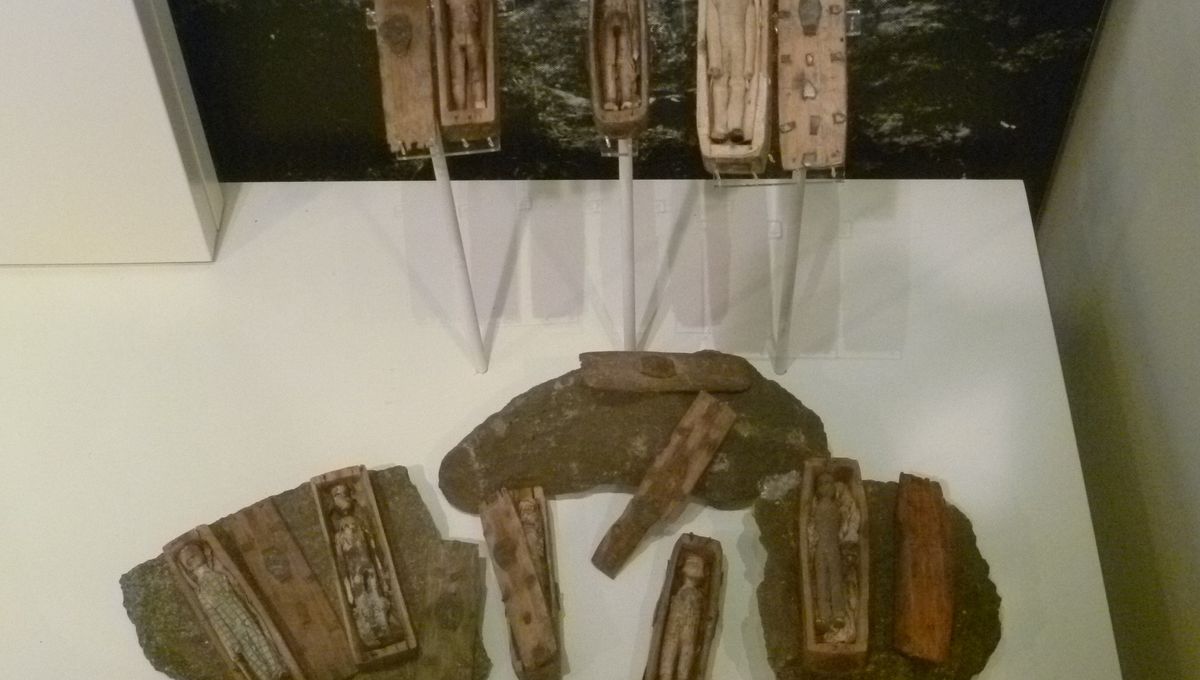
Just outside of Edinburgh, Scotland are the slopes of Arthur’s Seat, a small mountain once created by a now-extinct volcano. Rumored to have once been the site for King Arthur’s Camelot, the location is steeped in historical lore and mystery.
In 1836, a group of young boys were out on a rabbit hunt in the misty hills of Arthur’s Seat, only to find a cache of 17 wooden palm-sized coffins whose existence and creation stump historians and researchers nearly two centuries later.
Measuring just 95 millimeters (3.7 inches) in length, the coffins were said to have been laid out in two rows of eight with a third row of just one coffin. Held within each coffin is a small, wooden figure adorned with carefully stitched customized clothing that experts have dated to 1830.
Today, nearly two centuries later, the origins and intentions of the remaining eight coffins still elude historical and archaeological experts.
From witchcraft and surrogate burials to serial killer memorabilia and a madman’s obsession, below are the predominant theories that experts have proposed throughout the decades in an attempt to explain the creation of the “Lilliputian” coffins.
A tool for vengeful witchcraft
With ties to whimsical history, Arthur’s Seat is an evocative place, prompting some experts to suggest that the tiny coffin-bound figures were meant to represent people targeted by witches.
But figures created for the purposes of witchcraft were made to be destroyed as a means of eliminating the enemy they represented, so to speak. The figurines appear to have been made with respect and care – not with malicious intent. This, historians say, disproves most theorized connections to witchcraft.
Honoring lost lives through surrogate burials
Perhaps the coffins and their inhabitants were created as a surrogate burial, some speculate. This notion was first proposed in an article published by the Edinburgh Evening Post on August 20, 1836, which speculated that the coffins resulted from “an ancient custom which prevailed in Saxony, of burying in effigy departed friends who had died in a distant land.”
Similarly, on August 25, 1836, the newspaper Caledonian Mercury theorized that the figurines were created to represent sailors lost at sea whose wives had attempted to give them a “Christian burial.”
Though compelling, there is no evidence that this custom was practiced in Scotland. Because the figurines are nearly identical in shape and size – with wide-set eyes and a pointed nose, it’s unlikely that each was created to represent an individual person. What’s more, historians argue that such a surrogate burial would have been marked by a historical event in which 17 people perished, yet no such record exists for the area at the time.
The workings of a “single individual mental aberration”
Anecdotal claims reported by the Edinburgh Evening News in 1836 suggested that the miniature graveyard could have been the “result of a single individual’s mental aberration.”
An anonymous letter published by the newspaper described a “man who was not only deaf and dumb, but also ‘daft’” who turned up in town in a state of excitement after the coffins had been discovered. Local gossipers speculated that the coffins were his handiwork, and he was distraught at the thought his cemetery was discovered.
Mythological mandrakes stowed by merchants
In 1976, Dr Walter Hâvemick, then-director of the Museum fur Hamburgische Geschichte in Germany, published a description of the coffins, linking their creation to the “belief in the supernatural properties of a mandrake in a coffin.”
Some traditions follow entombing mandrake roots in miniature coffins to symbolize helpful spirits that bring luck to their owners. Hâvemick proposed, again without evidence, that the cache of coffins found at Arthur’s Seat were perhaps stashed there by a merchant to be sold later.
Tokens stashed by serial killers
Perhaps the most salacious of the theories is that the coffins were created and stashed by the infamous 19th-century serial killer duo, William Burke and William Hare. Known as the West Port murders, between 1827 and 1828, Burke and Hare were responsible for the death of 16 people whose corpses would be supplied for dissection to medical students at the time.
Proposed in an issue of The Journal for Edinburgh History, a historical book published by the history group Old Edinburgh Club, the theory holds that the coffins and their inhabitants were created by the murderers to memorialize their victims.
There are flaws with this theory as well. For example, the figurines are not fashioned to be individualistic – 12 of Burke and Hare’s 17 victims were female, yet all of the miniature corpses were dressed as men.
The mystery continues nearly two centuries later
IFLScience contacted more than half a dozen experts who could not explain their origins.
Without a viable explanation, the enigmatic coffins hold as much mystery in the 21st century as they did nearly two centuries prior. Today, the “celebrated Lilliputian coffins” are housed and on display at the National Museum of Scotland.
Source Link: The Centuries’ Old Mystery Of The Arthur’s Seat Coffins